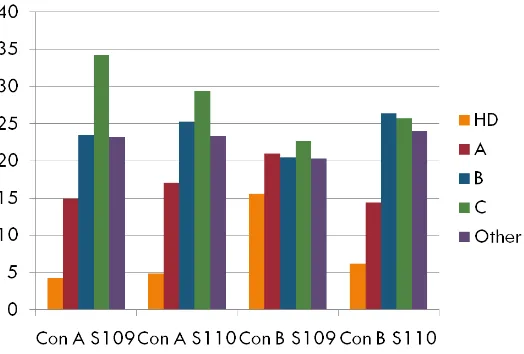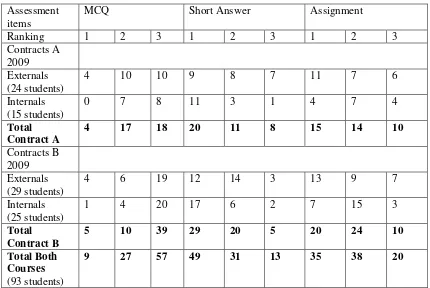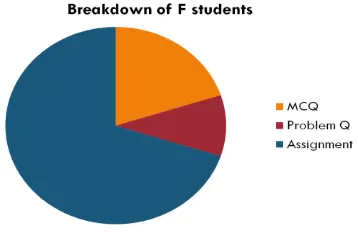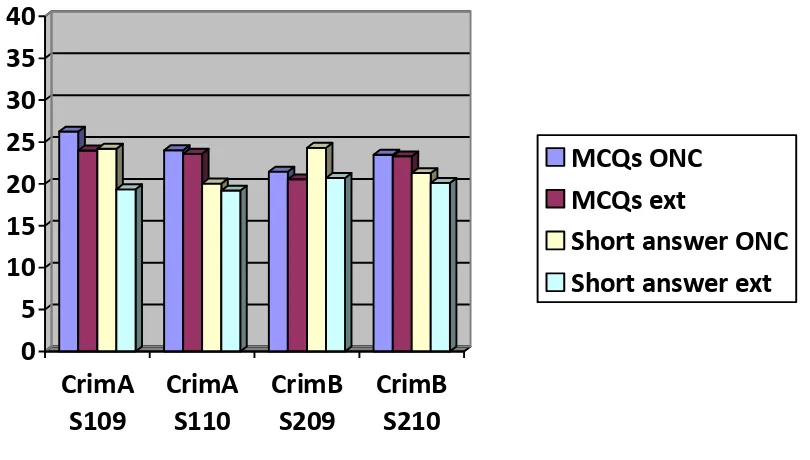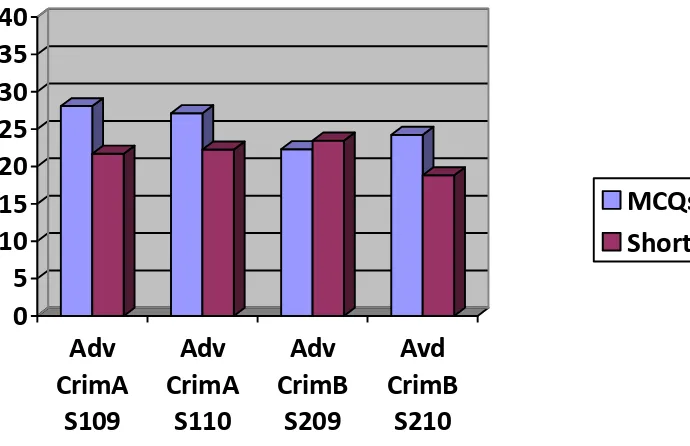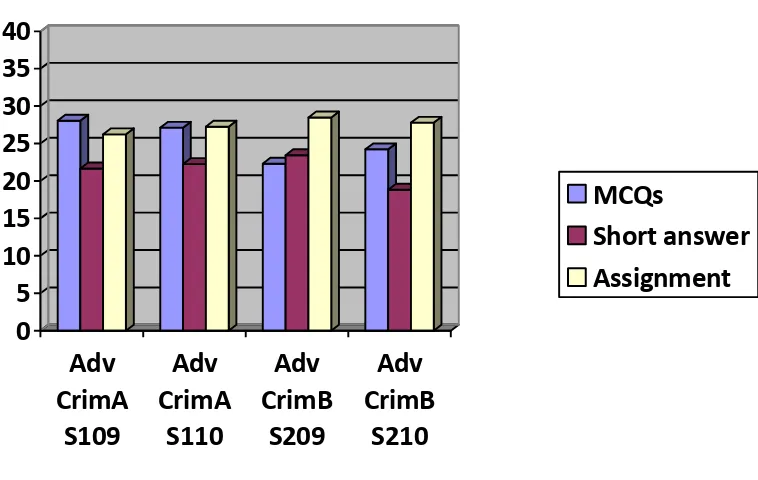Noeleen McNamara1 Eola Barnett*
ABSTRACT
This article reports on an investigation undertaken by the authors on the verity of multiple choice questions (MCQs) as components of summative assessment in first level core courses within a law program. Student results are compared across different years where the only variable was the use of MCQs substituted for a research assignment. Comparison will be made about results of the general student body, as well as higher performing students and those who failed the courses to gauge whether either group is favoured by having MCQs. Conclusions will be drawn about constraints and
opportunities from the authors’ experience in using MCQs in these courses.
Keywords: Legal education; pedagogy; multiple choice questions; summative assessment.
INTRODUCTION
This article reports on one aspect of an investigation undertaken by the authors on the verity of multiple choice questions (MCQs) as a teaching and learning and assessment tool in law courses within a law program: that of the use of MCQs for summative assessment in core first year law courses. The other aspect of this investigation was the verity of MCQs as formative assessment in core first year law courses (see Barnett & McNamara 2012). Given that both papers deal with the use of MCQs, the literature considered is similar and has provided the framework for both.
The investigation was primarily triggered by debate regarding the use of MCQs in law and specifically the poor reputation suggested by some academics (Higgins & Tatham 2003; Nichol 2007). A secondary trigger for this investigation was thus to inform their continued use and determine where, if at all, MCQs fit within current views in legal education pedagogy. They are often viewed as a soft option leading to a heightened unrealistic performance (Higgins & Tatham 2003), an option not suited to law, or inappropriate in that they encourage surface learning and fail to address higher order learning (Selby, Blazey & Quilter 2008, p. 207; Kvale 2005; Hinett & Bone 2002, p. 72). As Case and Donahue state (2003, p. 2), ‘they are viewed as less intellectually rigorous than essay questions and less realistic in their relationship to the actual practice of law’.
On the other hand MCQs have long been used with success for both formative and continuous or final summative assessment in many disciplines and on many levels of learning (Roberts 2006). There appears to be an acceptance of MCQs in law schools in the United States (Selby et al. 2008, pp. 204-205 referring in particular to Miller 1997) and by the American Bar Association and the United Kingdom providers of the Bar Vocational Course (Higgins & Tatham 2003, p. 2). In Australia, however, there has been and still is a reluctance to accept
Noeleen McNamara ([email protected]) and Eola Barnett ([email protected]) are lecturers in law, Faculty of Business and Law, University of Southern Queensland, Australia.
*
and/or use MCQs in legal education, except perhaps when teaching larger enrolment law courses such as Business Law for multiple disciplines (Selby et al., 2008). As such there is considerably more literature on the use of MCQs in other disciplines than for courses within a law program (Garrison, Hansen & Kneopfle 2007).
Both authors have used MCQs over the last three years as components (cf totality) of summative assessment in first year core law courses. Considerations regarding the structuring and writing of good MCQs to address different levels of learning is already the subject of extensive research, particularly in a generic sense and again focussed on other disciplines.2 This article presupposes that MCQs used are drafted in line with the literature to achieve course objectives and acknowledges that the key to the effective use of MCQs is proper construction, as is the case with other forms of assessment; ‘the particular question format or combination of formats is not as important as the skill and sophistication with which the questions are crafted and the exam as a whole is assembled and graded’ (Case & Donahue 2008, p. 373).
THE PEDAGOGY OF MCQS AS SUMMATIVE ASSESSMENT: THE ISSUES
Arguments regarding the use of MCQs for summative assessment, for and against, abound in the literature. Many of the principal ones are canvassed by Biggs (2007), Selby et al (2008) and Higgins and Tatham (2003).
Biggs points out that assessment choice affects student approaches to their learning. The use of MCQs encourages a rote learning approach and is as such ‘an enemy of understanding’ (Biggs 2007 quoting Gardner 1993, p. 204). This problem is exacerbated when MCQs are used to assess recall as opposed to functioning knowledge which, he believes, is better assessed using alternative methods such as problem based short answer and essay questions (Biggs 2007, pp. 197, 234, 238).
Another concern about MCQs is that they encourage game playing as students adopt methodologies suited to MCQ exams, e.g. guessing by a process of elimination, always
choosing ‘all of the above’ and choosing the longest alternatives (Biggs 2007, pp. 174, 203). A further issue is that they can be time consuming to construct properly and that they present difficulties for authenticating examinees where tests are undertaken remotely online.
2
There are many university guides available on the internet: Ballantyne, C Multiple Choice Tests
<http://www.tlc.murdoch.edu.au/eddev/evaluation/mcq/mctests.html> at 9th June 2010; Designing and Managing MCQs: Application of Blooms Taxonomy to the design of MCQs <http://web.uct.ac.za/projects/cbe/mcqman/mcqappc.html> at 9th June, 2010; Lasso, R Taking Multiple Choice Exams <http://www.caslpa.ca/PDF/examprep_documents/Taking%20Multiple%20Choice%20Exams1.pdf> at 9th June, 2010; University of Technology Sydney, Multiple choice questions
Advantages of MCQ summative assessment commonly mentioned include the cost benefit gains of rapid [and flexible] assessment (Biggs 2007, pp. 203, 232). MCQs offer a superior advantage in terms of assessing knowledge of content (breadth of coverage) (Case & Donahue 2008, p. 373; Selby et al 2008, p. 204) and consistent marking and resource saving, including effort toll (Selby et al 2008, p. 204).3 These considerations are attractive with burgeoning student numbers and the consequential squeeze on resources. As Nicol states
‘larger student numbers, reduced resources and increasing use of new technologies have led to the increased use of MCQs as a method of assessment in higher education courses’ (2007, p. 53). He further points out, referring to Bull and McKenna (2004), that ‘computer networks enable more flexibility in the delivery of MCQs (e.g. with delivery at times and places more in tune with student needs) and, with appropriate software, they automate and speed up marking and the collation of test results. Compared to paper-based MCQs, the use of online computer-assisted assessment can significantly reduce the burden associated with testing large student cohorts’ (Nicol 2007, p. 53). However Biggs cautions that the utility of MCQs can be attractive arguments for justifying their use in circumstances where alternative assessment is just as efficient (2007, p. 203).
Another advantage is that MCQs are marked objectively. This eliminates the subjectivity that can affect the marking of other forms of summative assessment such as problem based and essay short answer questions. However, Biggs questions the validity of this assertion of objectivity on the basis that subjectivity can affect the writing of MCQs, particularly when used for assessing higher order learning objectives (2007, p. 203).
MCQs also have a diagnostic value. Results of tests can be used to identify areas in which students are having problems—which can then be addressed where MCQS are used as progressive assessment, prior to the final exam. Results of MCQ exams can also be used to refine the test bank of questions for future exams.
MCQs also motive students to cover the whole of the course if they know that it is potentially examinable. Assignments only cover specific areas as do short answer questions on an exam
and students may be able to engage in ‘picking questions’ that are likely to constitute problem questions. University-imposed time limitation on hours (2 hours in our institution) means that the only feasible way of testing the whole course is by use of MCQs. These advantages are potentially heightened when combined with formative assessment (Barnett & McNamara 2012, pp. 79-84).
RESPONDING TO SOME OF THE ISSUES. MCQS CAN BE AN EFFECTIVE FORM OF SUMMATIVE ASSESSMENT IN CORE LAW COURSES
MCQs and their role in Blooms taxonomy
An appropriate knowledge base is the foundation of Blooms taxonomy of the cognitive domain, which is widely applied in many tertiary institutions, and from which emanates higher order learning objectives: understanding; applying; analysing; evaluating and creating (Anderson & Krathwoh 2001, pp. 67-68). ‘Researchers warn that higher education has focused for too long on inculcating and assessing those cognitive skills that are relatively easy
3
to acquire—remembering, understanding, and applying—rather than the arguably more therefore, it is still appropriate to ask knowledge-focused multiple-choice questions on an assessment’ (Selby et al. 2008, p. 209).
In certain circumstances where there are cogent reasons for their use, MCQs can be an appropriate method of summative assessment even if used for testing recall. This is acknowledged by Biggs himself when he considers the principle of alignment, ‘using the system (Computer Assisted Assessment) precisely for items that require rote learning such as terminology, rules and so on’ (2007, p. 238). If higher learning objectives require assessing using a MCQ format, questions can be drafted to reflect different levels of Blooms taxonomy to cover higher order learning objectives (see, for example, Selby et al. 2008). This is acknowledged widely in the literature.
Constructive and authentic learning
Constructive and authentic learning and assessment are popular current and sound pedagogies which are consistent with the theory that students learn better by doing. Viewed together they are based on the foundation that active learners construct their own knowledge, based on their existing knowledge, needs and learning style (Biggs & Tang 2007, p. 21), and that such knowledge is best constructed using authentic real world learning experiences and forms of assessment (Reeves & Okey 1996, Ch. 15); ‘authentic learning typically focuses on real-world, complex problems and their solutions, using role-playing exercises, problem-based activities, case studies, and participation in virtual communities of practice’ (Lombardi 2007, p. 2). Unless discovery learning is the goal, they require an existing knowledge base; they operate beyond the information given (Reeves & Okey 1996). The use of knowledge in these contexts will inculcate and build the required knowledge base, and support deeper learning outcomes. The relationship is synergetic.
Authentic learning and assessment should include as many of the higher order domains of Blooms taxonomy as possible taking into account the level at which a course is directed— foundational, intermediate or advanced (University of Southern Queensland 2010). The level will be determined by the knowledge base which supports it and the sophistication of authentic learning and assessment objective ranging from simple in class problems through to work integrated learning and assessment, so that learning is scaffolded through a degree program allowing for incremental learning.
solving, the development of skills is only as good as the knowledge base which supports the skill itself and of concepts within the legal context in which the skill is being used. Where the knowledge base is absent higher order learning occurs in a vacuum and is limited to generic concepts if it occurs at all. As such it will exist as an independent adjunct as opposed to an integrated whole.
Balancing assessment options
Diversification in assessment methods to achieve different learning outcomes of a course is
widely recognised; Hinett and Bone refer to the ‘holy trinity’ requiring an alignment between
content, learning outcomes and assessment (2002, p. 52). Minimum knowledge base and skills are mandated by well-established discipline standard requirements for legal education and pre vocational competency (see, for example, the Priestley Committee 1997; Pearce Report 1978), as well as tertiary education sector standards. Tensions exist regarding the appropriate balance between content knowledge, perspectives and skills, especially considering that for many a law degree is the pathway into the legal profession.
For the law lecturer, the problem then becomes how to achieve that balance within their course and, more broadly for the Law School or Faculty, how to achieve a balance across a law program. The equation is not simple and involves consideration of how much of a knowledge base is necessary to ensure graduate competency. ‘To students [assessment] is at the beginning’ (Biggs 2007); students are often strategic learners driven by assessment requirements and prioritise their studies accordingly (Daggett 2007; Selby et al. 2008). Assessment is a prime motivator, and needs to encourage student attention to the breadth of a course and not just several specific aspects.
Selby et al. state that ‘it is now recognized that no single form of assessment should comprise 100 per cent of the assessment types within a broader course of study’ (2008, p. 207). They also point out that ‘multiple choice testing will not generally be the sole determinant of a
student’s grade and a student will be exposed to a wider group of educational skills
throughout their higher education. Diversity in assessment is almost universally accepted and multiple-choice examinations fit into, rather than dominate, this diversity’ (2008, p. 207).
Boud argues for the need for a new conception of sustainable assessment for lifelong learning (2000, pp. 152, 155). He writes that assessment has two main purposes: certification (summative assessment) and aiding learning (formative assessment). Whilst he notes that both influence learning, he echoes Biggs’ view referred to above that summative assessment provides the de facto agenda for learning. As such, summative MCQs that potentially test the breath of the course provide the motivation for a student to gain an understanding of the whole course. This is particularly important for the foundation law courses, where knowledge will be assumed in later courses.
Taking into consideration the realities of modern legal education there is an argument for the use of MCQs given the nature of the study of law, legal education benchmarking and standards, current trends in pedagogy, resource constraints, and student numbers and profile.
With wider contextual considerations in mind and as a driver, both authors have used MCQs as summative assessment in core law courses in which they are involved. To inform the verity of their use, the next section will review results of MCQs used as a component of assessment in Contract Law and Criminal Law (both first year law courses).
STUDENT AVERAGE PERFORMANCE IN DIFFERENT FORMS OF SUMMATIVE ASSESSMENT
The method used in this investigation was to conduct a statistical quantative analysis of average student performance in summative assessment: assignments compared with MCQs and also short answer questions (problem based and essay). The analysis was based on a data set of student performance in four semester core courses, Contract Law A and B and Criminal Law A and B, over a two year period. Student performance was tracked in individual components of summative assessment: assignments, short answer exams (problem based and essay questions) and MCQ exams.
Contract Law
In 2009, the contract law courses (Contract A and Contract B) used a combination of research assignment (30%) and an end of semester exam (70%) for summative assessment. The exam consisted of two parts: Part A comprising 30 MCQs (30 marks) assessing knowledge from all modules of the course; and Part B comprising two problem questions (40 marks).
Primarily in response to staff and student concerns about the ability of first year students to conduct legal research given that it had not yet been covered in the law program, in 2010 the assessment for both contract law courses was amended to two online tests of MCQs held during the semester (comprising 10% and 20% respectively). The format of the end of semester exam remained similar to the previous year, however, Part A comprised only 20 MCQs (20 marks) and Part B comprised two problem questions (50 marks).
Comparison of 2009 and 2010 overall results in Contract A and Contract B
The data of 2009 and 2010 was analysed to determine if the results of students improved when the assignment in 2009 was replaced by MCQs in 2010. That is, were the MCQs a
‘soft’ option that lead to an overall inflation of results?
Figure 1 – Comparison of results of Contract Law A and B in 2009 and 2010.
Con A S109 = Contract A, Semester 1, 2009 Con A S110 = Contract A, Semester 1, 2010 Con B S109 = Contract B, Semester 2, 2009 Con B S110 = Contract B, Semester 2, 2010
Figure 2 compares the average result achieved in MCQs as compared with the problem questions on the final exam. The purpose of this figure was to test whether there was any difference in performance between on campus and external students in MCQs and problem questions. The results disclosed that there was little difference in performance on MCQs between the difference modes of offering. There was a bias in terms of better performance on the problem questions towards internal students—presumably because they have practised these exercises more frequently in tutorials.
Figure 2 – Comparison of results of in MCQ and Problem questions in Contract Law A and B in 2009 and 2010
disclosed that the majority of the top 20% of 2009 students in both Contracts A and B performed far better in both the assignment and the exam problem questions than in the exam MCQs. The external students performed better on the MCQs than the internal students, however, there was a stronger bias in internal student performance in the problem questions even among the high performing group.
Figure 3. Comparison of best results in assignment, MCQs and problem questions for top 20% of students
Table 1 provides further analysis of this data in terms of individual student performance and shows that there were some students who performed the best in MCQs, but certainly not the majority of students.
1 = highest result of the 3 assessment items 2 = second highest of the 3 assessment items 3 = lowest result of the 3 assessment items
Assessment
We believed that it was also relevant to consider the lowest performing students so results of the students who achieved a Fail grade were analysed. Results of these students are not as instructive. Whilst they showed a strong bias in favour of the assignment, this was due to the fact that several students completed the assignment but did not sit the final exam.
Figure 4. Comparison of best results in assignment, MCQs and problem questions for Fail students
Criminal law
The criminal law courses (Criminal Law A and Criminal Law B) used a combination of an assignment (40%) (a court visit in Criminal Law A/Advanced Criminal Law A (the postgraduate offering of the course) and an advocacy exercise in Criminal Law B/Advanced Criminal Law B) and an end of semester exam (60%) for summative assessment. The exam consists of two parts: Part A comprising 20 MCQs assessing knowledge of fundamental principles in criminal law; and Part B comprising three short answer questions using a mix of problem based and essay questions. Problem solving is a primary focus of seminars in the A courses and the advocacy exercise in the B courses. All of the criminal law courses have data banks of MCQs for each of the modules taught. These are available online and are used by students for formative purposes; as a learning tool for fundamental principles covered in the courses and as a self-testing tool. The responses to the quiz questions provide immediate feedback and references to course texts for further reading. These quizzes also provide students with the opportunity to practise for the exam.
0
5
10
15
20
25
30
35
40
CrimA
S109
CrimA
S110
CrimB
S209
CrimB
S210
MCQs ONC
MCQs ext
Short answer ONC
Short answer ext
Figure 5 Comparison of results of in MCQ and short answer questions (problem based and essay)(out of 40%) in Criminal Law A and B in 2009 and 2010
Like Contract Law, this shows little difference in performance between internal and external students in relation to their performance on MCQs. There is a slight bias in favour of internal student performance on the written short answer questions, however, this is not as marked as in Contract Law. This could be attributed to the fact that Criminal Law uses short answer essay as well as problem questions, whereas Contract Law has two longer problem questions and no short answer questions. In any event, it shows that the results achieved by the Criminal Law students in MCQs is not markedly higher than with the short answer (problem based and essay) questions and hence that they are not an ‘easy’ assessment task.
0
Figure 6 Undergraduate student performance averages (out of 40%) in exam MCQs and short answer (problem based and essay): Criminal Law A and Criminal Law B in 2009 and 2010.
0
Figure 7 Postgraduate student performance averages (out of 40%) in exam MCQs and short answers (problem based and essay). Advanced Criminal Law A & B in 2009 and 2010.
Figures 8 and 9 analyses data which is similar to that covered in Figures 3 and 4 for Contract Law. Figure 9 compares: student results in the assignment with the MCQs and short answer (problem based and essay) questions on the exam.
0
Figure 8 Undergraduate student performance averages (out of 40%) in MCQs, short answer (problem based and essay) exam and assignment.
The postgraduate offering of the course is included in Figure 9.
0
These results disclose a slight bias in favour of the assignment over the other forms of assessment, but this bias is not as marked as with Contract Law. This may be due to the fact that Criminal Law students have the opportunity to practise MCQs throughout the course, as they are provided for each topic in the course as items of formative assessment. The first part of this investigation concluded that students who undertake the majority of these formative assessment MCQs performed better than the students who did not do so (Barnett & McNamara 2012, pp. 79-84). The bias may also be partially due to the fact that, depending on their double degree combination, some students complete Contract Law in first year and Criminal Law in second year.
Overall, the results support the proposition that the level of difficulty across different components of the summative assessment methods investigated is reasonably proportionate.
CONCLUSIONS
The data analysed for Contract Law and Criminal Law showed that MCQs were not a ‘soft
option’ in which students performed noticeably better than the other forms of assessment.
Indeed, where more ‘higher order’ questions were asked in Contract Law B in 2010 results were significantly lower than in the previous year where a research assignment was used instead of MCQs. The results did not show any bias towards MCQs in lower performing students and students who failed the course. The results showed a slight bias in achievement by distance students in MCQs and may evidence a need for more intervention with these students in terms of problem solving and essay writing.
Student feedback regarding the assessment options used in both courses also highlighted some benefits that had not been anticipated. Several students reported that, in terms of the whole course load, it would be overwhelming to have another assignment and they acknowledged that online tests allow a significant amount of the course content to be covered. In terms of having MCQs on the final exam, student response ranged from a practical consideration that
‘it gives my hand a rest’ through to statements such as they provide an additional opportunity for students to demonstrate knowledge beyond the problem based questions and that doing the
MCQs first gives an ‘opportunity to start thinking the right way’ and ‘reminds you of
concepts that can be used in the problem questions’.
REFERENCES
Anderson, L & Krathwoh, D et al. 2001, A Taxonomy for Learning, Teaching, and Assessing:
A Revision of Bloom's Taxonomy of Educational Objectives,Longman, New York.
Australian Professional Legal Education Council (1997), Standards for the Vocational
Preparation of Australian Legal Practitioners,
<http://www.lawcouncil.asn.au/lacc/documents/historical-documents.cfm>, at 15th March 2012.
Ballantyne, C, Multiple Choice Tests, Murdoch University,
<http://www.tlc.murdoch.edu.au/eddev/evaluation/mcq/mctests.html> at 9th June 2010.
Barnett, E & McNamara, N 2012, ‘Supporting Learning in Law: Using Formative MCQ
Assessment in Criminal Law Core Courses’, International Journal of Organisational
Behaviour, 17 (2), 72-86.
Biggs, J 2007, ‘Aligning Teaching for Constructing Learning’, The Higher Education
Academy,
<http://www.heacademy.ac.uk/assets/York/documents/resources/resourcedatabase/id477_alig ning_teaching_for_constructing_learning.pdf>, at 21st October 2011.
Biggs, J and Tang, C 2007, Teaching for Quality Learning at University: What the student does, 3rd ed, Open University Press, Maidenhead, England.
Boud, D 2000, ‘Sustainable Assessment: Rethinking assessment for the learning society’,
Studies in Continuing Education, 22 (2), 151-167.
Case, S & Donahue, B 2008, ‘Developing high-quality multiple-choice questions for
assessment in legal education’, Journal of Legal Education, 58 (3), 372-387.
Consultative Committee of State and Territorial Law Admitting Authorities 1994, Report on
Uniform Practical Legal Training Requirements,
<http://www.lawcouncil.asn.au/lacc/documents/historical-documents.cfm>, at 15 March 2012.
Daggett, L 2007, ‘All the above: Computerized Exam Scoring of Multiple Choice Items’
(2007) Journal of Legal Education 57, 391-392.
Higgins, E & Tatham, L 2003, ‘Exploring the potential of Multiple-Choice Questions in
Assessment’ 2 (1) Learning and Teaching in Action,
<http://www.celt.mmu.ac.uk/ltia/issue4/higginstatham.shtml> at 9th June, 2010.
Hinett, K & Bone, A 2002, ‘Diversifying assessment and developing judgment in legal in legal education’ in Burridge, R, Hinett, K, Paliwala, A & Varnava, T (eds) Effective Learning
and Teaching in Law, 49-77, Kogan, London.
Hughes, C, Using MCQs for formative and summative purposes: A discussion paper prepared
for the Assessment Subcommittee of the UQ Teaching and Learning Committee, University of
Kvale, S 2007, ‘Contradictions of assessment for learning in institutions of higher learning’ in
Boud, D & Falchikov, N (eds) Rethinking Assessment in Higher Education: Learning for the
Longer Term, Routledge, London, 57-71.
Lasso, R, Taking Multiple Choice Exams,
<http://www.caslpa.ca/PDF/examprep_documents/Taking%20Multiple%20Choice%20Exams 1.pdf> at 9th June, 2010.
La Trobe University, A Guide to using Multiple Choice Questions and other Objective Test
Questions,
<http://www.latrobe.edu.au/teaching/assets/downloads/Guide%20to%20objective%20test%2 0item%20writing.pdf> at 9th June, 2010.
Law Council of Australia, Law Admission Consultative Committee, ‘Competency Standards for Entry Level Lawyers’,
< http://www.lawcouncil.asn.au/shadomx/apps/fms/fmsdownload.cfm?file_uuid=30440CF8-1C23-CACD-222E-59CF362D9B5A&siteName=lca>, at 15th March 2012.
Lombardi, M 2007, ‘Authentic learning for the 21st Century: An Overview’, EducauseLearning Initiative, <http://net.educause.edu/ir/library/pdf/ELI3009.pdf> at 31st October, 2011.
Miller, D 1997, ‘Using Examinations in First-Year Legal Research, Writing and Reasoning
Courses’, Legal Writing: Journal of Legal Writing Institute, 3,217-233.
Nicol D 2007, ‘E-assessment by design: using multiple-choice tests to good effect’, 31 (1)
Journal of Further and Higher Education, 31 (1), 53-64.
Pearce, D, Campbell, E & Harding, D 1987, Australian Law Schools: A Discipline
Assessment for the Commonwealth Tertiary Education Commission (Pearce Report), AGPS,
Canberra.
Reeves, T & Okey, J 1996, ‘Alternative assessment for constructivist learning environments, in Wilson, B (ed), Constructivist learning environments: Case studies in instructional design, Educational Technology Publications, New Jersey, United States.
Roberts, T 2006, ‘The use of multiple choice tests for formative and summative assessment’.
Paper presented to the Eighth Australasian Computing Education Conference (ACE2006), Hobart, Tasmania, <http://crpit.com/confpapers/CRPITV52Roberts.pdf>, at 21st October 2011.
Selby, J Blazey, P & Quilter, M 2008, ‘The relevance of multiple choice assessment in large cohort business law units’Journal of the Australasian Law Teachers Association, 1, 203-212.
University of Cape Town, Designing and Managing MCQs: Application of Blooms Taxonomy
to the design of MCQs, <http://web.uct.ac.za/projects/cbe/mcqman/mcqappc.html> at 9th
University of Southern Queensland, Learning and Teaching Support, Thinking about different learning levels for your course,
<http://www.usq.edu.au/~/media/USQ/learnteach/Information%20flyers/Gradqualitiesdiffere ntlevels%209%20Dec%2009.ashx > at 19th March, 2010.
University of Technology Sydney, Multiple choice questions,
